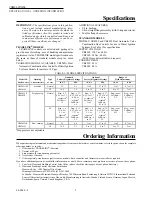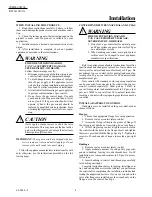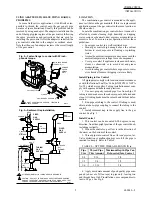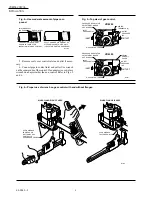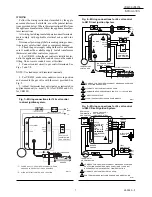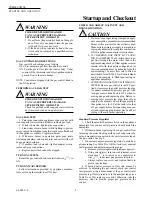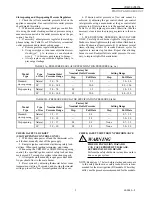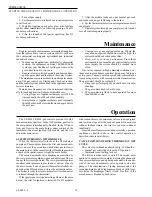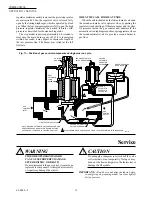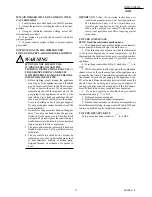
11
68-0049—2
VR8205; VR4205
␣ ␣ ␣ ␣ ␣ ␣ ␣ OPERATION
WHEN THERMOSTAT CALLS FOR HEAT
When the thermostat calls for heat, the DI module
generates a spark at the main burner and the first automatic
valve and second automatic valve operators are energized
(Fig. 11). The first automatic valve opens, and the second
automatic valve operator valve disc is lifted off its seat.
This diverts gas flow from the second automatic valve
diaphragm, and causes a reduction of pressure on the
underside of this diaphragm. The reduced pressure on the
bottom of the automatic valve diaphragm repositions the
diaphragm downward, away from the valve seat, allowing
gas to flow to the main burner.
Standard Regulation
During the ON cycle, the servo pressure regulator pro-
vides close control of outlet pressure, even if inlet pressure
and flow rate vary widely. Any outlet pressure change is
immediately reflected back to the pressure regulator dia-
phragm, which repositions to change the flow rate through
the regulator valve, and thus through the automatic valve.
If outlet pressure begins to rise, the pressure regulator
diaphragm moves slightly higher, allowing less gas flow to
the gas control outlet. This increases gas pressure under the
automatic valve diaphragm and repositions the valve disc
closer to the seat. Thus, flow of gas through the second
automatic valve is reduced, and outlet pressure falls to the
desired level.
If outlet pressure begins to fall, the pressure regulator
diaphragm moves slightly lower, allowing more gas flow to
the gas control outlet. This decreases gas pressure under the
second automatic valve diaphragm and repositions the
valve disc further from the seat. Thus, flow of gas through
the second automatic valve is increased. and outlet pressure
rises to the desired level.
Fig. 10—Position of gas control components during thermostat off cycle.
Slow-Opening Regulation
Slow-opening gas controls function the same as stan-
dard models except that when the thermostat calls for heat,
the second automatic valve opens gradually. Opening is
slowed because a flow restructure in the passage from the
second automatic operator slows the rate at which gas
pressure is reduced under the second automatic valve dia-
phragm after the second automatic operator opens. Outlet
pressure to the main burner increases gradually from 0 in.
wc [0 kPa] to rated output pressure within 3-6 seconds (for
an 80,000 Btuh furnace at 7 in. wc [1.8 kPa] inlet pressure
and 3.5 in. wc [0.9 kPa] outlet pressure).
Step-Opening Regulation
Step-opening gas controls actually combine two pres-
sure regulators, one for the low pressure and one for the
full-rate pressure. When the thermostat calls for heat, the
automatic operator valve disc opens. The low pressure
FIRST
AUTOMATIC
VALVE
SOLENOID
CONTROL
KNOB
GAS
CONTROL
INLET
SECOND AUTOMATIC
VALVE OPERATOR
SECOND
AUTOMATIC
OPERATOR
SOLENOID
SECOND
AUTOMATIC
OPERATOR
VALVE DISC
SERVO PRESSURE
REGULATOR
GAS
CONTROL
OUTLET
SECOND AUTOMATIC
VALVE DIAPHRAGM
FIRST AUTOMATIC VALVE
NOTE: AUTOMATIC VALVE OPERATOR AND SERVO
PRESSURE REGULATOR SHOWN OUTSIDE GAS
CONTROL FOR EASE IN TRACING GAS FLOW.
SLOW-OPENING GAS CONTROL HAS A GAS FLOW RESTRICTOR IN THIS PASSAGE.
M9114
1
1


